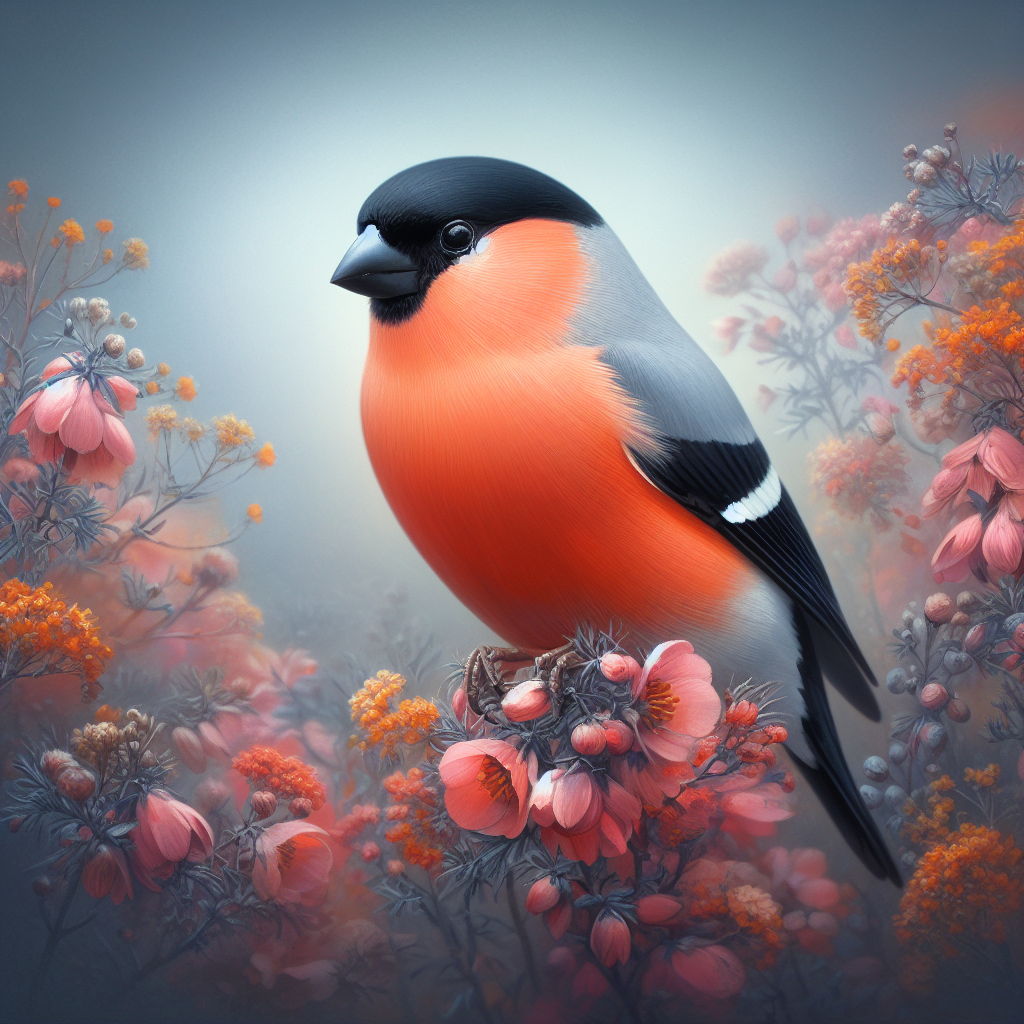Most beautiful small birds - Sykalo Eugen 2024
Bullfinch (Pyrrhula pyrrhula)
Identification:
- Species name: Bullfinch
- Scientific name: Pyrrhula pyrrhula
- Family: Fringillidae (Finches)
- Order: Passeriformes (Songbirds)
- Subclass: Neornithes (Modern birds)
- Class: Aves (Birds)
Description:
- Size: Small, plump finch, about 15 cm (5.9 in) long with a wingspan of 25-28 cm (9.8-11 in).
- Body shape: Stocky and rounded, with a short neck and a large, powerful bill.
- Plumage color:
Males: Strikingly colorful with a rosy-red breast, black cap, white rump, gray back, and black wings with a white wingbar.
Females: Similar pattern but with more muted colors, often with a brown or gray wash over the red breast.
- Beak: Short, thick, and conical, black in color, perfectly adapted for crushing seeds.
- Legs: Short and black.
- Tail: Short and square.
Behavior:
- Method of feeding: Forages in trees and bushes, primarily eating seeds, buds, and berries. Also eats insects, especially during breeding season.
- Reproduction: Builds nests in dense shrubs or trees, often close to the ground. Lays 4-6 pale blue eggs with dark markings. Both parents care for the young.
- Movement: Resident in most of its range, but some populations may move to lower elevations or more southern areas in winter.
- Communication: Soft, whistling song and a variety of calls, including a distinctive "pew" sound.
Ecology:
- Habitat: Woodlands, forests, hedgerows, parks, and gardens with dense vegetation.
- Diet: Primarily seeds, buds, berries, and insects.
- Hunting methods: Forages on branches and twigs, using its powerful bill to crush seeds and extract buds. Also catches insects in flight or on foliage.
Distribution: Found across Europe and Asia, from the British Isles to Japan. Absent from southern Europe and parts of Southeast Asia.

Don't underestimate the seemingly plump Bullfinch, a resident of European and Asian woodlands. Beneath its rosy breast and charcoal cap lies a treasure trove of hidden secrets and captivating quirks that will leave you charmed by this feathered songster:
Rosy Ruby Feast: Bullfinches aren't just pretty; they're fruity gourmets. Their thick beaks are perfectly adapted to crack open tough berries and seeds, allowing them to enjoy a winter banquet of rose hips, hawthorn berries, and even frozen apples. Imagine them as feathered fruit punchers with built-in nutcrackers!
Unexpected Architects: Forget twigs and leaves; Bullfinches take nest-building to a whole new level. They craft cozy homes using moss, lichens, and even feathers, creating soft, insulated chambers for their chicks. Talk about feathered interior designers with a flair for the natural!
Singing Secrets: The Bullfinch's song isn't just a simple chirp; it's a complex masterpiece. They can imitate other birds, incorporate musical phrases, and even adjust their melody based on the season and their mood. It's like a feathered composer with built-in remix capabilities!
Winter Wanderers: Unlike many songbirds that migrate south for the winter, Bullfinches are bold winter warriors. Their thick feathers, efficient metabolism, and resourceful foraging skills allow them to thrive in snowy landscapes, feasting on frozen fruits and hidden seeds. Talk about feathered Vikings with built-in snowshoes!
Social Singers: Bullfinches aren't solitary songsters. During the winter months, they gather in loose flocks, perching together on branches and sharing their melodic repertoire. These feathered choirs fill the frosty air with vibrant harmonies, warming the hearts of nature lovers.
Unexpected Tool Users: Recent research suggests Bullfinches might be smarter than we thought. They have been observed using twigs and sticks as tools to pry open stubborn berries and access insects hidden in crevices. Talk about feathered MacGyvers with built-in pocket toolkits!
Symbiotic Symphony: Bullfinches play a crucial role in the ecosystem. By dispersing seeds through their droppings, they help regenerate forests and woodlands, contributing to the vibrant tapestry of nature. These rosy rubies act as feathered gardeners with built-in fertilizer systems!
Unexpected Color Change: Did you know? Bullfinches undergo a subtle yet intriguing color change during the breeding season. The males' breasts become a deeper, richer red, while the females develop a rosy flush on their underparts. It's like feathered lovebirds putting on their spring fashion show!